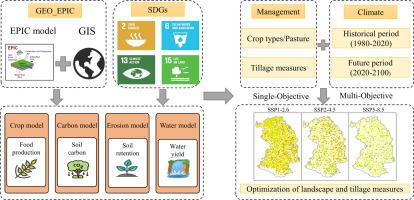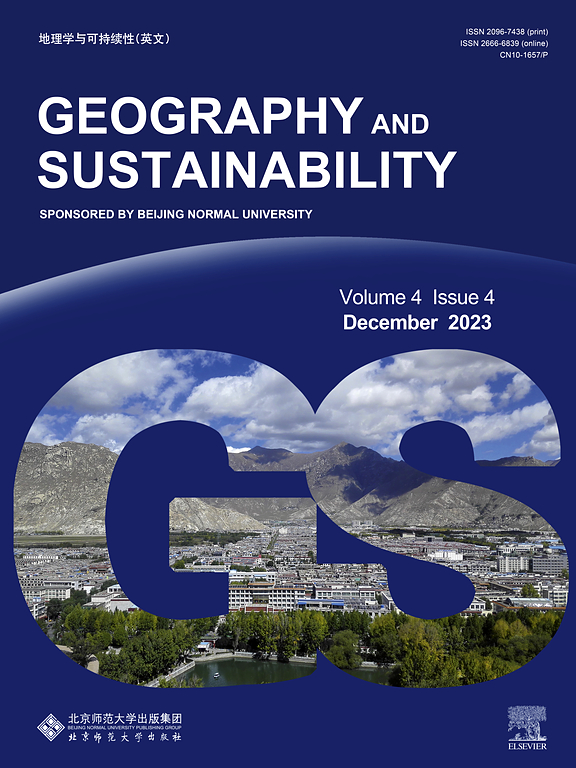Proactive adaptation to climate change in landscape configuration and agricultural management optimization: A case study of agro-pastoral transitional zone in northern China
IF 8
1区 环境科学与生态学
Q1 GEOGRAPHY, PHYSICAL
引用次数: 0
Abstract
Optimizing landscape patterns and management measures would be an effective strategy for the agro-pastoral transitional zone in northern China (ATNC) to adapt to future climate change. Existing studies generally focus on cropland or pasture, and thus there is a lack of comprehensive understanding of the landscape composition and configuration in complex agro-pastoral transitional zone. In this study, Ansai County in the ATNC was chosen as an experimental area. Four typical agroecosystem services (AESs), food provision (FP), soil carbon (SC), soil retention (SR) and water yield (WY) from 1980 to 2020, were simulated by spatially integrating a model of the agricultural system using the Environmental Policy Integrated Climate (EPIC) combined with geographic information systems technology. The impacts of different crop types, pasture configurations, and tillage practices on AESs under future climate scenarios were assessed in the context of agro-pastoral transition. Finally, the optimal landscape pattern configuration and management measures were identified through single-objective and multi-objective optimization models. The results showed that under historical scenarios, implementing policies such as converting cropland to pastureland improved SC and SR but reduced FP and WY. Compared to traditional and reduced tillage, no-till practices benefited the enlargement of AESs and the agricultural ecosystem. Notably, future climate change generally negatively affected AESs, especially under the Shared Socioeconomic Pathway (SSP5–8.5) climate scenario. The combination of planting corn and no-till measures would be ideal for optimizing the agricultural ecosystem in Ansai County. For the fragile ATNC, we should advocate conservation agriculture and policies converting cropland to pastureland to mitigate the adverse impacts of climate changes. This study establishes a replicable framework to address landscape management in complex agropastoral systems and offers solutions for climate-resilient land management in global dryland transitional zones, contributing to the realization of regional ecosystem sustainability.

景观配置对气候变化的主动适应与农业管理优化——以中国北方农牧交错带为例
优化景观格局和管理措施将是中国北方农牧交错带适应未来气候变化的有效策略。现有研究主要集中在农田或牧场,缺乏对复杂农牧交错带景观组成和配置的全面认识。本研究选择安塞县为试验区。利用环境政策综合气候(EPIC)与地理信息系统技术相结合的农业系统空间整合模型,对1980 ~ 2020年的粮食供应(FP)、土壤碳(SC)、土壤保持率(SR)和产水量(WY) 4种典型农业生态系统服务进行了模拟。在农牧过渡背景下,评估了未来气候情景下不同作物类型、牧草配置和耕作方式对农业生态系统的影响。最后,通过单目标和多目标优化模型确定了最优景观格局配置和管理措施。结果表明:在历史情景下,退耕还草等政策的实施提高了土壤SC和SR,降低了土壤FP和WY;与传统和少耕相比,免耕有利于扩大农业生态系统和农业生态系统。值得注意的是,未来气候变化普遍对AESs产生负面影响,特别是在共享社会经济路径(SSP5-8.5)气候情景下。玉米种植与免耕措施相结合是优化安塞县农业生态系统的理想选择。对于脆弱的亚太地区,我们应该提倡保护性农业和将耕地转为牧场的政策,以减轻气候变化的不利影响。本研究为解决复杂农牧系统景观管理问题建立了可复制的框架,并为全球旱地过渡带气候适应型土地管理提供了解决方案,有助于实现区域生态系统的可持续性。
本文章由计算机程序翻译,如有差异,请以英文原文为准。
求助全文
约1分钟内获得全文
求助全文
来源期刊

Geography and Sustainability
Social Sciences-Geography, Planning and Development
CiteScore
16.70
自引率
3.10%
发文量
32
审稿时长
41 days
期刊介绍:
Geography and Sustainability serves as a central hub for interdisciplinary research and education aimed at promoting sustainable development from an integrated geography perspective. By bridging natural and human sciences, the journal fosters broader analysis and innovative thinking on global and regional sustainability issues.
Geography and Sustainability welcomes original, high-quality research articles, review articles, short communications, technical comments, perspective articles and editorials on the following themes:
Geographical Processes: Interactions with and between water, soil, atmosphere and the biosphere and their spatio-temporal variations;
Human-Environmental Systems: Interactions between humans and the environment, resilience of socio-ecological systems and vulnerability;
Ecosystem Services and Human Wellbeing: Ecosystem structure, processes, services and their linkages with human wellbeing;
Sustainable Development: Theory, practice and critical challenges in sustainable development.
 求助内容:
求助内容: 应助结果提醒方式:
应助结果提醒方式:


